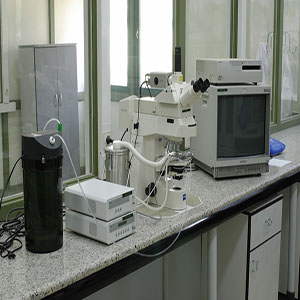Mineralogy
In this laboratory, minerals are studied and identified in terms of mineralogical compositions using existing devices and equipment, there are advanced and modern equipment in this laboratory, some of which are explained.
 Microscopic studies
Microscopic studies  X-ray Diffraction (XRD)
X-ray Diffraction (XRD)  Scanning Electron Microscope (SEM)
Scanning Electron Microscope (SEM)  DTA-TGA
DTA-TGA  Sample Preparation
Sample Preparation  Mineralogy-Fluid inclusion Studies
Mineralogy-Fluid inclusion Studies
Description:
Identifying and studying the liberation degree of minerals in various mineral samples
Equipment list:
ZEISS Axioplan 2 transmission and reflection polarizing optical microscope made in Germany
Description of services that can be provided:
- Identification of metallic and non-metallic minerals present in thin, thin-polished and polished sections of mineral samples
- Petrographic studies of rock and mineral samples
- Microscopic and liberation degree studies on fractionated samples along with
- identification of texture, inclusions, waste conflicts with mineral ore, dimensions and percentage of minerals.
Explanation:
Studying the crystalline structure of a material using X-rays
Equipment list:
Philips Xpert pro model XRD machine, made in the Netherlands
Description of services that can be provided:
- Identification of crystalline phases in all kinds of mineral and synthetic samples in powder form
- Presence or absence of asbestos in the sample
- Presence or absence of crystalline silica in the sample
Explanation:
Studying various samples in the field of mineral processing and metallic samples. through point and bulk analysis of different phases checking the surface morphology of powdered samples, and studying fracture sections by examining different types of ceramic and geological samples.
Equipment list:
Leo Scanning Electron Microscope, model 1450VP, made by Leo, Germany
Service Description:
Providing images with magnifications ranging from 40 to 50,000 times, creating 3D images using a Secondary Electron Detector (SE), producing 2D images using a Back Scattered Electron Detector (BSE), and determining chemical composition and performing point and bulk analysis elementally using Energy Dispersive Spectroscopy (EDS).
Description:
This method is based on examining how a sample changes during heating according to a specific thermal program. These changes can include variations in crystal structure, phases, structural changes, loss of water molecules, chemical breakdown, and so on. Simultaneous Thermal Analysis (STA) combines thermogravimetry (TG) with differential thermal analysis (DTA).
Equipment list:
STA 409 PC Luxx thermal analysis device made by NETZSCH, Germany
Available services:
Thermal analysis of powder samples or small metal pieces up to a temperature of 1300 °C with varying heating rates, simultaneous implementation of thermogravimetric (STA) analysis- comparative thermal analysis (-TG DTA), provision of thermal analysis graphs (DTA) including endothermic and exothermic reactions at different temperatures, determination of peaks and onset and conclusion temperatures of reactions, determination of derivative graphs along with raw data, calculation of the area under the curve, and activation energy to study the kinetics of reactions.
Description:
preparation of microscopic sections, crushing and softening of XRD samples
Equipment list:
Cutting machine - Abrasion machine - Polishing machine - Hot press machine
Description of the services that can be provided:
Preparation of all types of thin, polished, thin-polished, powder-polished, thin-powder-polished, and double-polished sections
Description
Fluid inclusions are small volumes of paleofluids trapped in minerals which provide indispensable information about geological processes, from high temperatures at depth towards low temperatures near the Earth's surface. These inclusions are trapped gases, liquids or crystals, either trapped singularly (one-phase) or as a heterogeneous mixture of more than one phase (multi-phase) in a single cavity.
Equipment list
- Linkam THMS600 Stage (Temperature Range: -196°C to 600.0°C)
- TP94
- LNP
- Dewar (vacuum flask that holds N2)
- Water cooling (Flask water).
- Petrographic microscope: ZEISS (Axioplan 2 imaging)
Measuring parameters :
- The first melting point of ice or eutectic temperature (Te).
- The last melting point of ice (Tm ice ).
- homogenization temperature (Th).
- The dissolution temperature of salts (halite, sylvite,...).
- The temperature of different phases in the CO 2 system.
Application of fluid inclusions
- in mineral exploration
- determination of genesis
- oil discoveries
- geothermal systems
- Gemology



